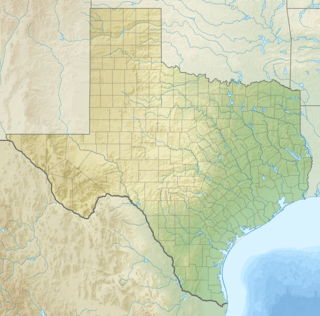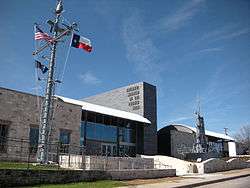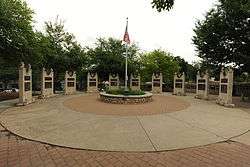National Museum of the Pacific War
|
Admiral Nimitz Museum | |
 National Museum of the Pacific War Location within Texas | |
| Established | February 24, 1969 |
|---|---|
| Location |
340 East Austin Street Fredericksburg, Texas United States |
| Coordinates | 30°16′21″N 98°52′03″W / 30.2726°N 98.8675°WCoordinates: 30°16′21″N 98°52′03″W / 30.2726°N 98.8675°W |
| Type | Maritime museum |
| Curator | Joe Cavanaugh |
| Website | National Museum of the Pacific War |
The National Museum of the Pacific War is located in Fredericksburg, Texas, the boyhood home of Fleet Admiral Chester W. Nimitz. Fleet Admiral Nimitz served as CinCPAC, Commander in Chief, United States Pacific Fleet during World War II. The six acre site includes the Admiral Nimitz Museum which is housed in the old Nimitz Hotel and tells the story of Fleet Admiral Nimitz beginning with his life as a young boy through his naval career as well as the evolution of the old hotel.
Nimitz Hotel
Charles Henry Nimitz, German merchant marine and grandfather of Fleet Admiral Chester Nimitz, was born in Bremen in Germany. He emigrated to the United States by way of South Carolina in 1844. In 1846, Nimitz moved to Fredericksburg with the initial settlers. In 1848, he married Sophie Dorothea Mueller, and nine of the couple's twelve children lived to adulthood.[1] Local trouble maker James P. Waldrip tried unsuccessfully to recruit Nimitz into Die Haengebande.[2] Charles Nimitz built the Nimitz Hotel in 1852, and deeded it over to his son Charles H. Nimitz, Jr., in 1906. Locals referred to it as the Steamboat Hotel because of the ship's bow front. The hotel had its own saloon and brewery, a ballroom that doubled as a theatre, a smokehouse, and a bath-house.[3] In its heyday, the hotel hosted such guests as Horace Greeley, Johnny Ringo, President Rutherford B. Hayes, General Robert E. Lee, General James Longstreet, General Phil Sheridan, William Sydney Porter and General Ulysses S. Grant.[4][5][6][7][8]
Anna Henke Nimitz, the wife of his son Chester Bernard Nimitz became pregnant with their only child Chester William Nimitz. The senior Chester died before his son was born on February 24, 1885. Little Chester's grandfather Charles served as a father figure the first five years of his life. In 1890, the widow Nimitz married her husband's brother William Nimitz and moved with him to Kerrville where he managed the St. Charles Hotel. While still a teenager, Chester was accepted for enrollment in the United States Naval Academy, where he graduated seventh out of a class of 114. Chester Nimitz rose to the rank of Commander-in-Chief of the U.S. Pacific Forces in World War II. Fleet Admiral Nimitz died February 20, 1966.[9]
The Nimitz Hotel was designated a Recorded Texas Historic Landmark in 1989, Marker number 10089.[10]
The Museum
The Admiral Nimitz Foundation was established in 1964 (as the Fleet Admiral Chester W. Nimitz Naval Museum, Inc.) to support a museum honoring Fredericksburg’s native son, Commander-in-Chief of Allied Forces, Pacific Ocean Area.

The hotel owned by Nimitz's grandfather Charles Henry Nimitz was restored to its original design and renamed the Admiral Nimitz Museum by an act of the Texas legislature in 1968.[11] The original intent was to focus only as a memorial to Fleet Admiral Chester Nimitz.[12] In 2000, the complex was renamed Admiral Nimitz State Historic Site - National Museum of the Pacific War and is dedicated exclusively to the Pacific Theater battles of World War II.[13] The conning tower of USS Pintado (SS-387) is at the main museum entrance.[14]
The Pacific Combat Zone is a re-creation of a Pacific island battlefield, and includes a Quonset hut hospital, a PT boat and base, Japanese tank, palm trees, and machine gun placements. Re-enactments, called Living History exhibits, are held throughout the year.[15] The Veterans' Walk of Honor and Memorial Wall can be found within the Memorial Courtyard.[16]
On May 8, 1976, the 130th anniversary of the founding of Fredericksburg, the Japanese government gifted the museum with the Japanese Garden of Peace. The garden was designed by Taketora Saita as a replica of the private garden of Gensui The Marquis Tōgō (1848–1934), the main Imperial Japanese Navy commander in the Russo-Japanese War.[17] Fleet Admiral Nimitz personally admired the Marquis Tōgō, having previously helped to establish a war memorial to the Japanese admiral.[18][19]

The outdoor Plaza of the Presidents was dedicated on September 2, 1995, the 50th anniversary of Fleet Admiral Nimitz' acceptance of the Japanese Instrument of Surrender aboard the USS Missouri (BB-63). The plaza is a tribute to the ten United States Presidents who served during World War II: Franklin D. Roosevelt (Commander in Chief), Harry S Truman (Commander in Chief), General of the Army Dwight D. Eisenhower (Army), John F. Kennedy (Navy), Lyndon B. Johnson (Navy), Richard Nixon (Navy), Gerald Ford (Navy), Jimmy Carter (Navy), Ronald Reagan (Army) and George H. W. Bush (Navy).[20][21]
George H.W. Bush cut the ribbon in 1991 for the $3 million gallery bearing his name. The George H.W. Bush Gallery is home to an I.J.N. Ko-hyoteki class midget submarine (which participated in the attack on Pearl Harbor), a Japanese Kawanishi N1K "Rex" floatplane, and an American North American B-25 Mitchell. In 1991, the land for the Bush Gallery was bought from H-E-B Grocery.[13] Money for the gallery was privately raised in the 1990s through the efforts of finance chairman Lee Bass and a board that included baseball star Nolan Ryan and Ernest Angelo, a former mayor of Midland. Admission tickets cover both museums.
Bush later reflected that "terrifying experiences" of war helped him to become a man: "I have often wondered why me, why was I spared when others died."[22]
On December 7, 2009 the museum hosted the Grand Re-Opening of the newly expanded George H. W. Bush Gallery where the second floor houses the Nimitz Education and Research Center. Former President George H. W. Bush his wife Barbara, along with Texas Governor Rick Perry, cut the ribbon. The ceremony was attended by survivors of the Attack on Pearl Harbor, and drew a crowd of 5,000 people.[23]
See also
- List of museums in Central Texas
- National D-Day Memorial
- National World War II Memorial
- National World War II Museum
- United States Marine Corps War Memorial (Iwo Jima)
- List of Texas state historic sites
References
- ↑ Kohout, Martin Donell. "Nimitz, Charles Henry". Handbook of Texas Online. Texas State Historical Association. Retrieved 14 November 2010.
- ↑ Adam, Thomas (2005). Germany and the Americas: Culture, Politics, and History. ABC-CLIO. p. 384. ISBN 978-1-85109-628-2.
- ↑ Potter, E B (1976). Nimitz (Potter). US Naval Institute Press. p. 23. ISBN 978-0-87021-492-9.
- ↑ Jamison, Cheryl (1993). Texas Home Cooking. Harvard Common Press. p. 501. ISBN 978-1-55832-059-8.
- ↑ Johnson, David (1996). John Ringo. Barbed Wire Pr. p. 78. ISBN 978-0-935269-23-9.
- ↑ Larrabee, Eric (2004). Commander in Chief: Franklin Delano Roosevelt, His Lieutenants, and Their War. US Naval Institute Press. p. 355. ISBN 978-1-59114-455-7.
- ↑ Carmack, Liz (2007). Historic Hotels of Texas: A Traveler's Guide. TAMU Press. p. 236. ISBN 978-1-58544-608-7.
- ↑ Kohout, Martin Donell. "Nimitz Hotel". Handbook of Texas Online. Texas State Historical Association. Retrieved 11 November 2012.
- ↑ Weddle, Robert S. "Nimitz, Chester William". Handbook of Texas Online. Texas State Historical Association.
- ↑ "Nimitz Hotel". Recorded Texas Historic Marker. William Nienke, Sam Morrow. Retrieved 13 February 2011.
- ↑ "National Museum of the Pacific War| Museum Beginnings".
- ↑ "Natl Museum of the Pacific War". Texas Tourist Guide. Retrieved 23 December 2010.
- 1 2 Hallowell, John (2007). "Fredericksburg's Nimitz Museum". Texas Hill Country Magazine (Fall).
- ↑ NavSource Naval History USS Pintado Photo Page
- ↑ Brandt, Terry (7 December 2003). "Town Zeroing in on Tourism with Military Flair". Amarillo Globe News.
- ↑ Forehand, J C R (2010). The German Soldier that Sergeant York Never Met. Tate Publishing. p. 144. ISBN 978-1-61663-950-1.
- ↑ "Togo Heihachiro". Encyclopædia Britannica Online. Encyclopædia Britannica. Retrieved 23 December 2010.
- ↑ "Garden of Peace-Fredericksburg". Texas Monthly: 112. August 1991.
- ↑ Kohout, Martin Donell. "National Museum of the Pacific War". Handbook of Texas Online. Texas State Historical Association. Retrieved 23 December 2010.
- ↑ "Plaza of the Presidents". Pacific War Museum. Retrieved 23 December 2010.
- ↑ Naylor, June (2008). Quick Escapes Dallas/Fort Worth, 6th: Getaways in and around the Lone Star State. GPP Travel. p. 87. ISBN 978-0-7627-4558-6.
- ↑ Museum exhibit, Pacific Gallery, Fredericksburg, Texas
- ↑ "George H.W. Bush Opens New War Museum". United Press International, Inc. 8 December 2009.
External links
| Wikimedia Commons has media related to National Museum of the Pacific War. |